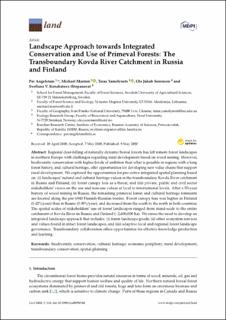| dc.contributor.author | Angelstam, Per | |
| dc.contributor.author | Manton, Michael | |
| dc.contributor.author | Yamalynets, Taras | |
| dc.contributor.author | Sørensen, Ole Jakob | |
| dc.contributor.author | Kondrateva (Stepanova), Svetlana V. | |
| dc.date.accessioned | 2021-02-02T13:59:44Z | |
| dc.date.available | 2021-02-02T13:59:44Z | |
| dc.date.created | 2020-10-22T08:25:39Z | |
| dc.date.issued | 2020 | |
| dc.identifier.citation | Angelstam, P., Manton, M., Yamalynets, T., Sørensen, O. J., Kondrateva (Stepanova), S. V. (2020). Landscape Approach towards Integrated Conservation and Use of Primeval Forests: The Transboundary Kovda River Catchment in Russia and Finland. Land, 9(5): 144. doi: | en_US |
| dc.identifier.issn | 2073-445X | |
| dc.identifier.uri | https://hdl.handle.net/11250/2725860 | |
| dc.description.abstract | Regional clear-felling of naturally dynamic boreal forests has left remote forest landscapes in northern Europe with challenges regarding rural development based on wood mining. However, biodiversity conservation with higher levels of ambition than what is possible in regions with a long forest history, and cultural heritage, offer opportunities for developing new value chains that support rural development. We explored the opportunities for pro-active integrated spatial planning based on: (i) landscapes’ natural and cultural heritage values in the transboundary Kovda River catchment in Russia and Finland; (ii) forest canopy loss as a threat; and (iii) private, public and civil sector stakeholders’ views on the use and non-use values at local to international levels. After a 50-year history of wood mining in Russia, the remaining primeval forest and cultural heritage remnants are located along the pre-1940 Finnish-Russian border. Forest canopy loss was higher in Finland (0.42%/year) than in Russia (0.09%/year), and decreased from the south to the north in both countries. The spatial scales of stakeholders’ use of forest landscapes ranged from stand-scale to the entire catchment of Kovda River in Russia and Finland (~2,600,000 ha). We stress the need to develop an integrated landscape approach that includes: (i) forest landscape goods; (ii) other ecosystem services and values found in intact forest landscapes; and (iii) adaptive local and regional forest landscape governance. Transboundary collaboration offers opportunities for effective knowledge production and learning | en_US |
| dc.language.iso | eng | en_US |
| dc.publisher | MDPI | en_US |
| dc.rights | Navngivelse 4.0 Internasjonal | * |
| dc.rights.uri | http://creativecommons.org/licenses/by/4.0/deed.no | * |
| dc.title | Landscape Approach towards Integrated Conservation and Use of Primeval Forests : The Transboundary Kovda River Catchment in Russia and Finland | en_US |
| dc.type | Peer reviewed | en_US |
| dc.type | Journal article | en_US |
| dc.description.version | publishedVersion | en_US |
| dc.rights.holder | © 2020 The Author(s) | en_US |
| dc.subject.nsi | VDP::Landbruks- og Fiskerifag: 900::Landbruksfag: 910::Naturressursforvaltning: 914 | en_US |
| dc.subject.nsi | VDP::Landbruks- og Fiskerifag: 900::Landbruksfag: 910 | en_US |
| dc.subject.nsi | VDP::Landbruks- og Fiskerifag: 900::Landbruksfag: 910::Skogbruk: 915 | en_US |
| dc.source.pagenumber | 27 | en_US |
| dc.source.volume | 9 | en_US |
| dc.source.journal | Land | en_US |
| dc.source.issue | 5 | en_US |
| dc.identifier.doi | 10.3390/land9050144 | |
| dc.identifier.cristin | 1841354 | |
| dc.relation.project | Andre: Marcus and Amalia Wallenbergs Minnesfond | en_US |
| dc.relation.project | Andre: FORMAS | en_US |

